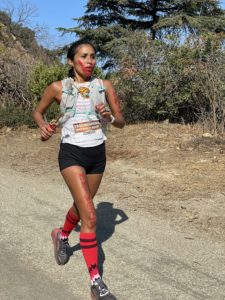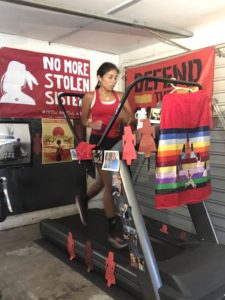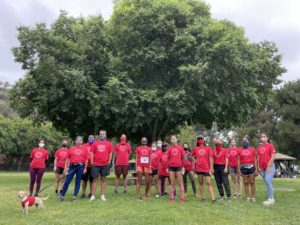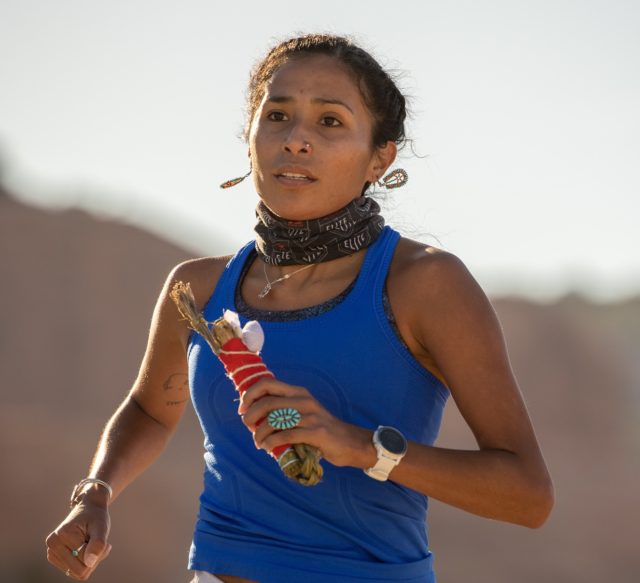A Conversation with Jordan Marie Brings Three White Horses Daniel
by Leah Etling
As the running industry continues to implement inclusive change, Race Director Magazine recently had the chance to speak with Jordan Marie Brings Three White Horses Daniel, a fourth-generation Lakota runner who has used her running talent and platform to bring Indigenous runners and causes to mainstream attention.
Daniel is involved in vital change-making efforts to make Indigenous runners seen, recognize land origins where running events take place, create awareness for missing and murdered Indigenous women, and much more.
As she describes in her own words: “I am an organizer. I am a voice. I am a connector—working to uplift and center Indigenous, Black, and Brown voices within our communities and spaces to demand justice, visibility, and respect as it intersects across all climate—racial, social, and economic justice movements.”
Daniel was kind enough to give us some of her valuable time to talk about running, advocacy and much more. Read on to hear how her nonprofit’s mission could directly benefit your next event.
RDM: What prompted you to see the act of running or the experience of bodily movement as a place where you could also be a voice for change?
Daniel: I began attending marches and rallies in 2013 to stop the Keystone XL pipeline—a pipeline that would harm and impact my Tribe in South Dakota. I began organizing in August 2016, where I organized the Run For Water Rally for the Indigenous youth who were running to oppose the pipeline. They inspired me to see that running is not just about fitness, not just about a fast time, not just about trying to get a sponsor. It is not even about trying to focus on your health and wellness. It is about really believing in something that you want to stand for.
Those youth running over 2,000 miles (from North Dakota to Washington D.C.) inspired me to see how running can carry a message. Sport is so celebrated in the U.S., and so are stories that pull at the heartstrings and capture our emotions. Being able to intersect the two, having a purpose or a cause that you are fighting for, and weaving it with something that you truly love, like running and movement, is a beautiful way to build community that will help raise awareness and hopefully impact change.
RDM: You have run multiple races in honor of Missing and Murdered Indigenous Women. Tell us about why you did that?
Daniel: Initially I had not brought causes into my races because I was still up-and-coming (as an athlete) and trying to qualify for the U.S. Olympic Marathon Trials. And running was also my stress outlet, so I wanted to keep that separate. But because the epidemic of missing and murdered Indigenous women and relatives is so important to me, it just came down to the lack of visibility, support for, and awareness about this issue.
These murders and disappearances are happening not just on reservations and rural communities, but everywhere. Being a survivor of violence myself, it truly was heartbreaking. These women were not getting the visibility they needed or deserved. So that led me to running the 2019 Boston marathon for 26 Missing and Murdered Indigenous Women and children.
RDM: Can you share why you decided to make a major race into a highly visible plea for action?
Daniel: It was really the lack of support for Indigenous communities around this issue. This is an epidemic that is happening. I got to the point where I gave up on trying to organize panels to talk about it, or post about it on social media or create content or organize events.
I started to feel that if people do not care that another Indigenous person has gone missing or has been murdered, then I do not know what else to do. It felt like we meant nothing to other communities, that we are constantly forgotten or disposable.
The only thing I knew what to do about it, on an essential level, was run. Having learned about all the prayer run customs and best practices, I created my own prayer run. That brought me to the Boston Marathon.
RDM: Do you feel like you have seen any change since that 2019 Boston Marathon?
Daniel: The only change was to bring out more athletes to do the same thing. It inspired Rosalie Fish, who contacted me a week later, asking for my blessing to do the same thing at her state high school track meet in Washington. We are also seeing other  athletes—volleyball players, football players, basketball players—that are putting the red handprint on and raising awareness for the stolen loved ones and their families. So things are changing, but very, very slowly.
athletes—volleyball players, football players, basketball players—that are putting the red handprint on and raising awareness for the stolen loved ones and their families. So things are changing, but very, very slowly.
RDM: Tell us about the events you are organizing in support of this cause.
Daniel: My non-profit organization, Rising Hearts, continues to fundraise for this cause through our virtual runs. Our fifth annual Running for Justice event was held on May 5, the National Day of Awareness for Missing and Murdered Indigenous Women. We held a virtual 5K run and two in-person events in Los Angeles and Washington, DC. In 2021, we raised $77,000. This year, our goal was $250,000.
RDM: Now that those events have passed, how can the running community support you?
Daniel: Learn how you can become an ally to Indigenous communities and the people that are in this fight. Raising awareness, sharing and supporting the message, and taking the initiative to learn about this issue are all positive ways to take action. This is not a new issue. This has been going on, realistically, since colonialism arrived on these lands.
RDM: Speaking directly about land, what do race directors need to know about the spaces where their events take place and how they can appropriately recognize their provenance?
Daniel: I think race directors have an amazing opportunity to be more invested in creating a safe and inclusive space. And oftentimes, sadly, that process has not included Indigenous peoples in planning efforts. It has continued to perpetuate the narrative of Indigenous peoples are not here anymore. We are constantly erased from the conversation.
RDM: How has Rising Hearts worked to change that?
Daniel: We have an initiative called the Running on Native Lands Initiative. We work with race directors, running organizations and groups to implement land acknowledgments at their events and races. Our biggest success for land acknowledgement and working with race directors thus far has been the Boston Marathon, which happened on Indigenous Peoples Day in 2021.
RDM: How does this work for race directors or event organizations?
Daniel: You reach out to us if you want to become a partner, and we help connect you with the local Indigenous communities. We help facilitate those conversations and we serve as the protective buffer for the Indigenous communities. ![]()
But it is important that the end goal is to not just do a land acknowledgement and have it check a box. It is to go the extra mile in donating towards those local Indigenous communities or organizations and working with them to find out what more you can be doing. Maybe it’s offering comped entries, it’s donating a portion of entry fees towards community programs, or even donating the leftover race day food and snacks back into the community.
RDM: What is the message you want event participants to take from this effort?
Daniel: We want every participant that is there on race day to see the land acknowledgement practice and for it to become normalized. We want them to learn about whose lands that they are running on and recreating on and who the caretakers were, and still are.
RDM: Can you estimate how many races are currently engaged in this work?
Daniel: We have over a dozen partners right now. It has been great working with them. We’re trying to get them to also not just focus on the Indigenous components, but also how can we make the whole event more inclusive, how can we make sure that anyone can come and sign up for this race and feel like they’re being seen and being supported.
RDM: Any examples of what that looks like?
Daniel: One of the things that we do with our virtual races is have an inclusive registration process. When you are asked to select gender, in addition to female or male, we put in an option for non-binary and an option for two-spirit. We have had so many messages coming in from people who identify as non-binary or two-spirit, saying that they have never seen this before, even though they have signed up for many different events. They tell us that this is the first event where they felt seen, felt respected, and felt supported.
RDM: What closing message would you like to leave race directors with?
Daniel: It’s an ongoing conversation with race directors that we continually try to push for. We wanted to educate them as to how the lands they are on have a long history of continuously erasing Indigenous peoples. Even though they might not physically be present there anymore, you must think about all the impacts and situations that came before.
You are more than likely going to have Indigenous peoples in the local community, town or city where your event is taking place. So how can you host it in a way that is honoring and uplifting the Indigenous peoples that are on those lands? All these conversations that we have with race directors are very informative and educational. And in the end, we are hoping Rising Hearts can bow out, because now you are communicating and working together. We are about bringing people together, getting them introduced and making sure that this is a long-lasting relationship and kinship.
Learn More:
Jordan Marie Brings Three White Horses Daniel website: https://www.jordanmariedaniel.com/
Rising Hearts website: https://www.risinghearts.org
Running on Native Lands initiative: https://www.risinghearts.org/nativelands

